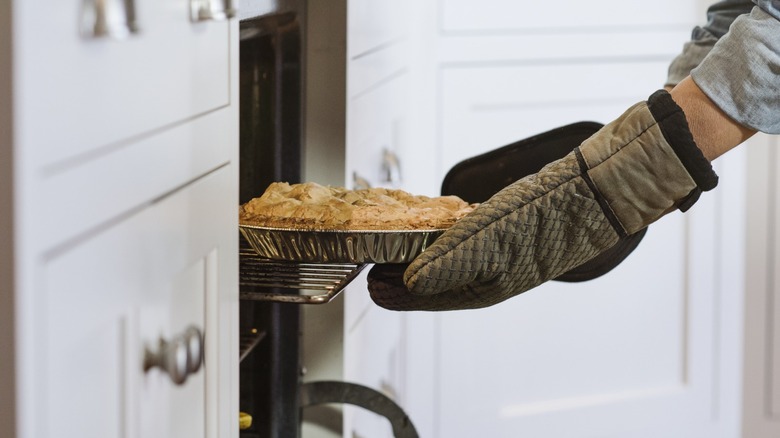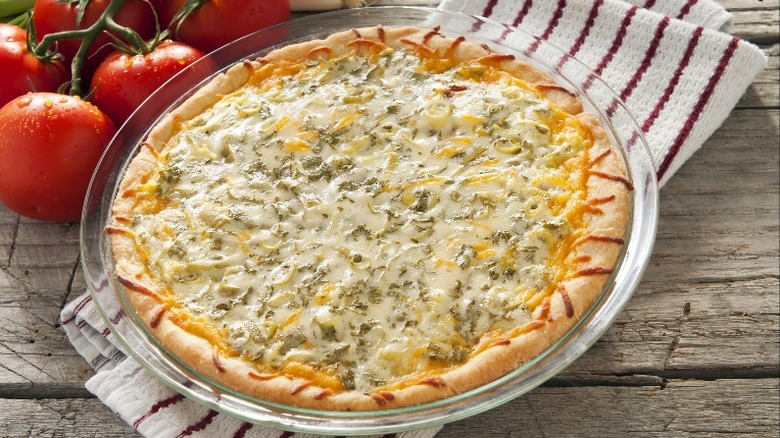Are You Using The Right Pan When Baking Pie?
We may receive a commission on purchases made from links.
Author David Mamet claims, "Stress cannot exist in the presence of a pie." Clearly, Mamet has never been the one responsible for baking a pie. And the stress starts before you even start mixing the pie crust. The most pertinent first question that needs answering is: Which pan is the right pan for my pie?
There are many kinds of pie pans on the market, but the most-used types are probably metal, glass, ceramic, and silicone. Each type has its own pros and cons, and understanding how they work better equips you to decide which pie pan is best for your needs, whether you're rolling out a double crust for an iconic all-American apple pie, crushing graham crackers for a banana cream pie, or prepping Ree Drummond's secret-ingredient chicken pot pie filled with roast chicken, chopped veggies, and a thyme-scented sauce.
Metal pie pans
Often called tins, and probably the most ubiquitous, metal pie pans are many bakers' beloved choice for the flakiest, crispiest crusts. They're relatively inexpensive and conduct heat quickly and efficiently, making them especially appropriate for recipes that require you to blind-bake your pie crust, such as Boston cream or key lime pie. Metal pie pans also fare well in all temperatures, making it safe to broil or freeze or even to transfer your pie from a hot oven to a cold refrigerator if you need to.
All that being said, there are a few things to keep in mind when buying a metal pie pan. First, it's better to opt for a light-colored metal like aluminum, as the darker ones promote the over-browning of delicate pie crust. Avoid nonstick pie pans altogether, as a well-made, properly cooked crust guarantees a slice that slides right out of the pan, and nonstick makes it tough to check that. Plus, most pies are cut in the pan, a surefire way to damage a nonstick coating. Besides, if you're making a pie with a crumb crust, nonstick is a quick path to frustration, as the crust won't adhere to the sides of the pan.
Opt for aluminum or aluminized steel over stainless steel, as it's a superior conductor of heat. USA Bakeware's 9-inch aluminized steel pie pan is sturdy and well reviewed. If you're looking for disposable, KitchenDance heavyweight aluminum foil pie pans hold up well to heavy fillings.
Ceramic pie pans
Certainly the prettiest — and the most expensive — of options, brightly decorated ceramic pie plates make quite the splash at any get-together. Of the three types of pie pans, ceramic takes the longest to come to temperature but retains heat well once it gets to the desired level. When using ceramic pie pans, it's wise to position your pie in the lower part of your oven, closer to the heat. Because of its poor initial conductivity, ceramic pie pans are nice for longer-cooking double-crust pies in which the bottom crust tends to brown before the top crust and filling are done.
However, due to its decorative nature, ceramic pie pans tend to be oversized — deeper and wider than the standard 9-inch pie plate with a 1½- to 2-inch depth. The size differences and material also make ceramic pie plates heavier and unwieldy, a potential recipe for disaster. Opt for something that's affordable, beautiful, and easy-to-use as well as scratch- and break-resistant and dishwasher safe, like the Emile Henry 9-inch pie dish.
Glass pie pans
Probably the most versatile of the three, glass pie plates are the darling choice for nearly all types of pies. Like ceramic, glass is an insulator and requires more time to come to temperature, but you can see the bottom crust bake and become golden, making it a boon for newbie pie-makers. Glass pie pans are also inexpensive and can rival metal pans in affordability.
Glass pie pans are typically made from either tempered or borosilicate glass. Both heat evenly but make pies take longer to cook than metal pans. Borosilicate, more popularly known as Pyrex, is less likely to break when dropped or from extreme temperature changes than other types of glass. But you still have to be careful, as glass can shatter, resulting in a dangerous mess in addition to a lost pie. Don't transfer hot glass pie plates to the fridge or refrigerated ones to the oven without allowing them to come to room temperature first.
Pyrex-brand 9-inch glass pie plates tend to be popular with bakers as a moderately attractive option that works well in most situations. They can be a bit shallow for some people's tastes, but they're moderately priced and stand up well over time.
Silicone
Silicone is one of the most recent workhorses found in bakers' kitchens, and it's easy to see why. First and foremost would have to be its reputedly nontoxic, nonstick surface allowing for easy release. But as with nonstick metal pans, if your crust is made correctly, that should never be an issue with any pie pan. Silicone is also lightweight and incredibly easy to clean — by hand or in your dishwasher.
Silicone's flexibility is one of its biggest downsides in pie-making. To transfer pies to the oven or maintain an unbroken crust in a silicone pie pan, you require a firm surface to set the silicone on. Additionally, silicone is notoriously bad at conducting heat, which in the case of pie translates into crusts that won't brown or, even worse, come out mushy.
However, silicone really shines when it comes to mini desserts of all kinds, including pies. Since you set those on top of larger baking sheets to transfer anyway, the flexibility isn't as much of a downside. And silicone does really well with intricate designs, making it the perfect mold for small tarts and pies with intricate crust detailing. The Webake silicone mini quiche and tart pans are just the right size for individual portions. Plus, silicone goes from oven to freezer without a hitch.




